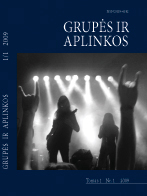Grupių elgesio modeliavimo link: naujieji pagonys
Towards Modelling Group Behaviours: Neo-Pagan Community
Author(s): Andrius Buivydas, Egidija Ramanauskaitė, J. Rimas VaišnysSubject(s): Cultural Essay, Political Essay, Societal Essay
Published by: Vytauto Didžiojo Universitetas
Keywords: dinaminės sistemos; grupių tyrimų metodai; neopagonys; dynamical systems; group research methods; neo-Pagans
Summary/Abstract: In this article we describe the properties and behaviour of a small group of Lithuanian neo- Pagans. The information was obtained by both observations and by a series of in-depth interviews, the latter organized in accord with a questionnaire constructed to elucidate group values and important interactions with the group environment. The information was collected and organized as guided by a dynamical systems approach, where each individual of the group is treated as a system whose total environment consists of all the other individuals and also the more general environment common to all the group members. This approach naturally groups the interactions between the chosen system and its environment into system inputs and system outputs which, however, are strongly modified by the system state. In turn changes in the system state are produced by system inputs which, in turn, may come about due to earlier system outputs directed to the environment. Thus feedback loops which either enhance or suppress selected behaviours can and do arise. The article presents a detailed description of the behaviour and properties of a selected group member in relation to her/his (so stated to protect the identity of the respondent) environment (the other group members and the more general overall influences) in terms of values and collections of values, i.e., variables. In the systems context, values are descriptions of behaviour which have been characterised specifically and unambiguously, while variables are named collections of related values. The use of such values in describing interactions requires the researcher to identify and relate, in a well defined way, aspects of a system (i.e., a chosen respondent) behaviour to uniquely identified and well specified aspects of the environment. At the same time, the need to be specific and concrete in characterising observations leads the researcher to identify and explicate his/her own ideological presuppositions. This process leads to observations and descriptions that other researchers can either identify with or falsify, thus increasing the objectivity level of the research process. In the article we give a detailed example of the way information is collected and transformed ,but do so only for one variable in each of the three important variable classes (system displays, system influences, system states responses/changes). Even so, it rapidly becomes clear that the number of discovered values is large and the number of interactions is even larger. Further, the ways in which different constituents of the group being studied interact is also complex. To manage this complexity we introduce tables which describe what values are associated with which constituents of the group description; these help in the systematic organization of the observations in our illustrative example and become indispensable if several variables are being described simultaneously. In this paper we also introduce
Journal: Grupės ir aplinkos
- Issue Year: 2009
- Issue No: 1
- Page Range: 87-124
- Page Count: 38
- Language: Lithuanian

